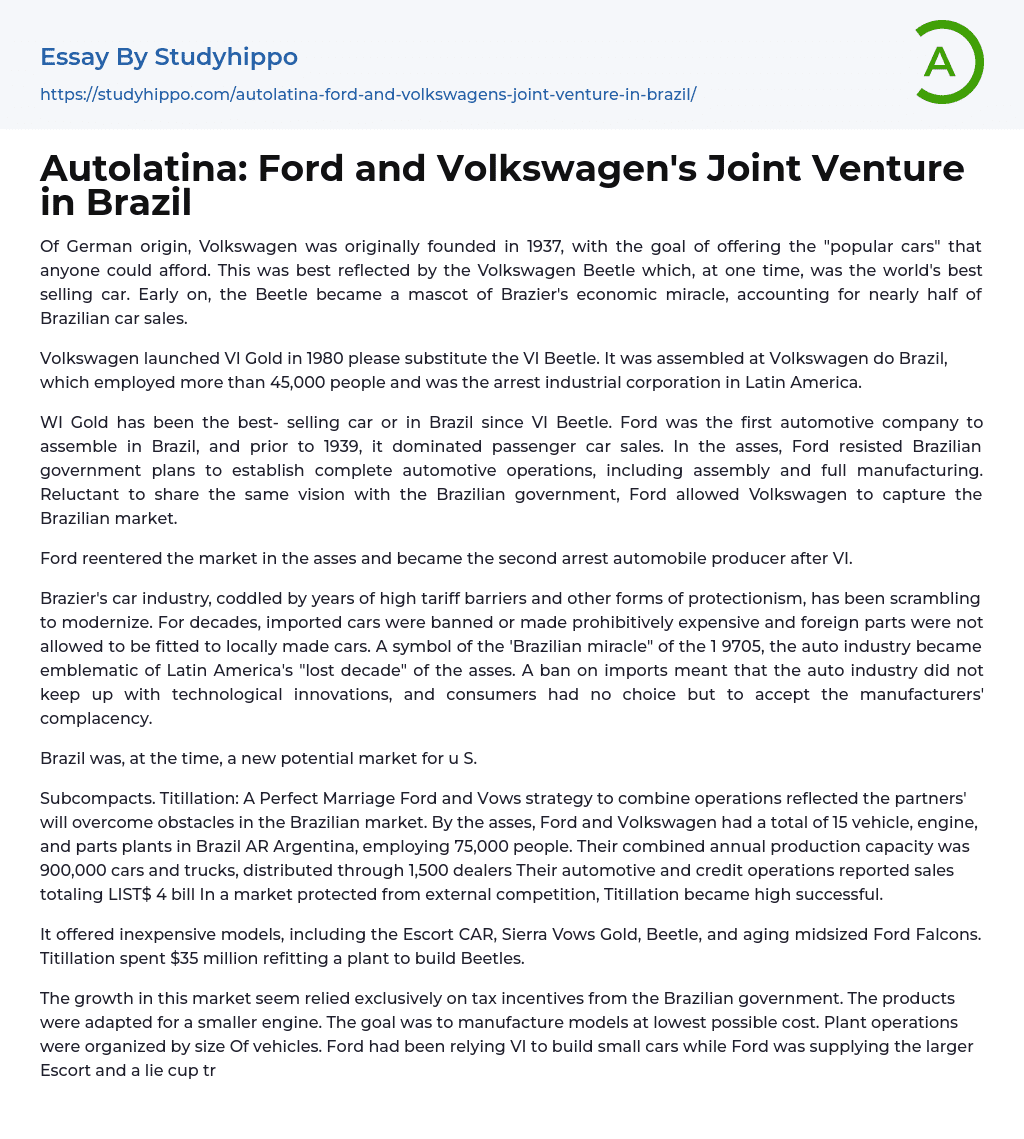

Autolatina: Ford and Volkswagen’s Joint Venture in Brazil Essay Example
Of German origin, Volkswagen was originally founded in 1937, with the goal of offering the "popular cars" that anyone could afford. This was best reflected by the Volkswagen Beetle which, at one time, was the world's best selling car. Early on, the Beetle became a mascot of Brazier's economic miracle, accounting for nearly half of Brazilian car sales.
Volkswagen launched VI Gold in 1980 please substitute the VI Beetle. It was assembled at Volkswagen do Brazil, which employed more than 45,000 people and was the arrest industrial corporation in Latin America.
WI Gold has been the best- selling car or in Brazil since VI Beetle. Ford was the first automotive company to assemble in Brazil, and prior to 1939, it dominated passenger car sales. In the asses, Ford resisted Brazilian government plans to establish complete automotive operations, includ
...ing assembly and full manufacturing. Reluctant to share the same vision with the Brazilian government, Ford allowed Volkswagen to capture the Brazilian market.
Ford reentered the market in the asses and became the second arrest automobile producer after VI.
Brazier's car industry, coddled by years of high tariff barriers and other forms of protectionism, has been scrambling to modernize. For decades, imported cars were banned or made prohibitively expensive and foreign parts were not allowed to be fitted to locally made cars. A symbol of the 'Brazilian miracle" of the 1 9705, the auto industry became emblematic of Latin America's "lost decade" of the asses. A ban on imports meant that the auto industry did not keep up with technological innovations, and consumers had no choice but to accept the manufacturers' complacency.
Brazil was, at the time
a new potential market for u S.
Subcompacts. Titillation: A Perfect Marriage Ford and Vows strategy to combine operations reflected the partners' will overcome obstacles in the Brazilian market. By the asses, Ford and Volkswagen had a total of 15 vehicle, engine, and parts plants in Brazil AR Argentina, employing 75,000 people. Their combined annual production capacity was 900,000 cars and trucks, distributed through 1,500 dealers Their automotive and credit operations reported sales totaling LIST$ 4 bill In a market protected from external competition, Titillation became high successful.
It offered inexpensive models, including the Escort CAR, Sierra Vows Gold, Beetle, and aging midsized Ford Falcons. Titillation spent $35 million refitting a plant to build Beetles.
The growth in this market seem relied exclusively on tax incentives from the Brazilian government. The products were adapted for a smaller engine. The goal was to manufacture models at lowest possible cost. Plant operations were organized by size Of vehicles. Ford had been relying VI to build small cars while Ford was supplying the larger Escort and a lie cup trucks.
The two partners even produced shared products. For instance, Volkswagen was prod icing Ford Versailles (derived from Santa), and for those producing VI Logos (derived from Ford Escort). Marketing and sales staff were unified. Specialists and consultants were I to accommodate the two different company cultures.
Production of Titillation cars rose substantially over time. In 1994, it see both companies had succeeded in identifying the key factors contribution Titillation's success: inexpensive, non-competing models, a growing racket, and sharing Of manufacturing and profits.
- Renault essays
- Truck essays
- chrysler essays
- The city essays
- Racing essays
- Bicycle essays
- Cars essays
- Rms Titanic essays
- Adidas essays
- Amazon essays
- Apple essays
- Bmw essays
- British Airways essays
- Burger King essays
- Coca-Cola essays
- Company essays
- Costco essays
- Dell essays
- Ebay essays
- Enron essays
- Facebook essays
- Ford Motor Company essays
- Gap essays
- General Motors essays
- Google essays
- Honda essays
- Ibm essays
- Ikea essays
- Intel essays
- Iphone essays
- Johnson and Johnson essays
- Kellogg essays
- Key essays
- Kfc essays
- Mcdonald's essays
- Microsoft essays
- Myspace essays
- Nestle essays
- Netflix essays
- Nike essays
- Nokia essays
- Pepsi essays
- Pepsico essays
- Red Bull essays
- Ryanair essays
- Samsung essays
- Sony essays
- Southwest Airlines essays
- Starbucks essays
- Supermarket essays



